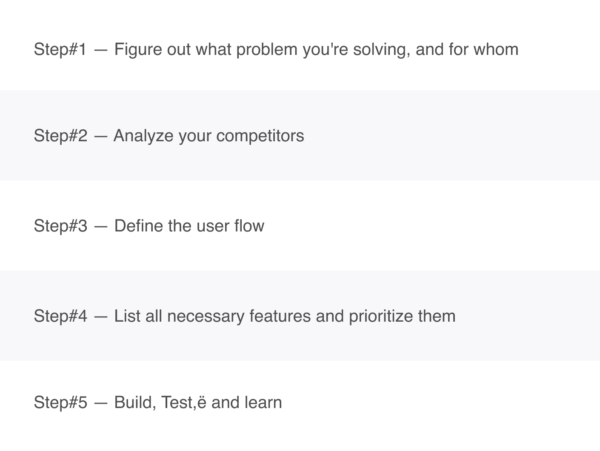Integrating that much work all at once is tedious, painful, and prone to error. This prevents errors and defects from progressing into software that should be as bug-free as possible. The first release of a software application is rarely “finished”; there are always more features and bug fixes.
- It is the main planning document for an IT project and describes how major aspects of the project will be executed and managed.
- Such a comparison might be incorrect as it’s like comparing a sedan with a helicopter.
- QA will also test the application to make sure that it can handle various use cases and is not prone to crashes or other bugs that could cause problems.
- Furthermore, developers will often create a software requirement specification or SRS document.
- The conceptual design stage is the stage where an identified need is examined, requirements for potential solutions are defined, potential solutions are evaluated, and a system specification is developed.
- All software begins as a concept, and progresses through a series of phases until a release is developed and deployed.
System design may be done conceptually using a pen and paper; it defines the system’s form and purpose. Next, a comprehensive, in-depth design is created, taking into consideration all logical and physical needs in terms of functionality and technology. The needs of the system’s final consumer must be determined and recorded so that those needs may be satisfied.
What are the phases in a Systems Development Life Cycle (SDLC)? FAQs
During this step, current priorities that would be affected and how they should be handled are considered. A feasibility study determines whether creating a new or improved system is appropriate. This helps to estimate costs, benefits, resource requirements, and specific user needs.

System Development Life Cycle or SDLC is a multistep, iterative process that helps to transform a newly developed project into an operative one in a methodical way. In the greater context of management information systems or MIS, SDLC helps managers to design, develop, test, and deploy information systems to meet target goals. SDLC models can therefore help projects to iterate and improve upon themselves over and over until essentially perfect. Since SDLCs have well-structured documents for project goals and methodologies, team members can leave and be replaced by new members relatively painlessly. SDLC models implement checks and balances to ensure that all software is tested before being installed in greater source code. But in theory, it illuminates the shortcomings of the main waterfall model by preventing larger bugs from spiraling out of control.
The System Development Life Cycle: A Phased Approach to Application Security
Most organizations have implemented at least one EHR and are either upgrading their current system or switching to a new system. The EHR is a longitudinal electronic record of patient health information generated by one or more encounters in any care delivery setting. Included in this information are patient demographics, progress notes, problems, medications, vital signs, past medical history, immunizations, laboratory data, and radiology reports.

LONDON — The British Government has committed nearly £4 billion, or $4.9 billion, to the next phase in the development of nuclear-powered submarines as part of the tri-national AUKUS program with Australia and the United States. This is the phase where where the data and components from the old system are moved to the new one. To make the most of this phase, you can start focusing on training during this phase. With web application security add an extra layer of protection to your application and stop DDoS attacks and data breaches before they even occur. SDLCs can also be more specifically used by systems analysts as they develop and later implement a new information system.
Keywords
Waterfall methods are still common, though Agile is rapidly pulling ahead. There is no perfect method, but it’s far better to use some method than none. Selecting the right technology is pivotal to your business’s growth and success. Connect with the Top 1% pre-vetted software engineers to build your software. Environmental Assessment The project is defined in terms of the support it provides to both the mission and the strategic plans of the organization. Healthcare information systems implementation time lines are often long, spanning 10 to 16 months for a full hospital information system implementation.
The SDLC provides a structured implementation approach to accomplish this. Develop detailed design specifications that translate functional specifications into a logical and physical design. Detailed phases of system development design specifications are developed during the design phase of the SDLC and describe how the system or application is designed to satisfy the requirements documented in the functional specifications.
Software development
While this chapter discusses phases of the SDLC related to an EHR implementation in an acute care setting, it is applicable to many healthcare settings and projects. To continue to meet new regulatory and professional standards, EHRs and software applications must be continuously updated and upgraded in the Maintenance Phase. Issues are added to the list and prioritized in relation to other issues and to the project goals and assigned an urgency status. The progress of an issue is tracked by the team on a regular basis with short progress notes added to the issue. When a resolution is reached, the resolution is documented in the issues list and the status is updated. A well-planned and executed implementation, on the other hand, provides a high level of risk mitigation and cost containment.
Now both system analysts and end-users should be able to see the realization of the project that implements the changes. Various modules or designs are integrated into the primary source code through developer efforts and typically use a training environment to detect further errors and defects. Before you start the planning phase, it’s a good idea to take the time to get a good understanding of your app development lifecycle. The final phase of the System Development Life Cycle, this is the phase where end users can fine-tune the system. In addition to this, new features can also be added to the system to meet the additional user requirements if necessary. It is the first phase of the system development process where it identifies if a new system is needed or not to achieve the desired objective.
DEVELOP PROJECT SCOPE
If the thorough analysis phase ends with a positive outlook for the project, the design phase can begin. The design phase is where the real work starts, and company resources start to fund the project. It is also the phase where the team figures out what the finished product will look like once development is completed, omitting potentially risky design choices along the way. By the end of this phase, the team will know what features it will have, and how its inner workings will be built. The system development life cycle component of the course introduces aspects of methodology, the unique phases, and the roles that IT professionals play in the various stages of a project. Students learn how to collect and document requirements, translate them to application design, and trace each project artifact to its original scope.

Later, the concepts of end-user perceptions determining project success in conjunction with streamlining clinician workflow–layered clinical systems projects with additional success criteria. Introducing a new clinical information system or component, including electronic health record systems, is a major undertaking for healthcare organizations. Approaching their introduction without strategy or planning will likely result in failure and disaster, sometimes causing harm to patients. In this chapter, we describe the system development life cycle (SDLC), a common framework for the introduction for new information systems in organizations.
Products and services
Despite many studies, the opinion about the effectiveness of techniques, principles, and methodologies is often based on the personal experience, emotional response, and competence of the manager who applied them. And only sometimes will the model you like from the description be the best for implementing your product. Therefore, the more you know methodologies and understand the product needs, the greater your ability to manage projects by combining best practices to achieve the objectives. It’s not simple to answer this question just because SDLC models carry various combinations of phases, suggesting different approaches. For instance, have you ever tried to compare Waterfall with Scrum or Waterfall and Agile?
